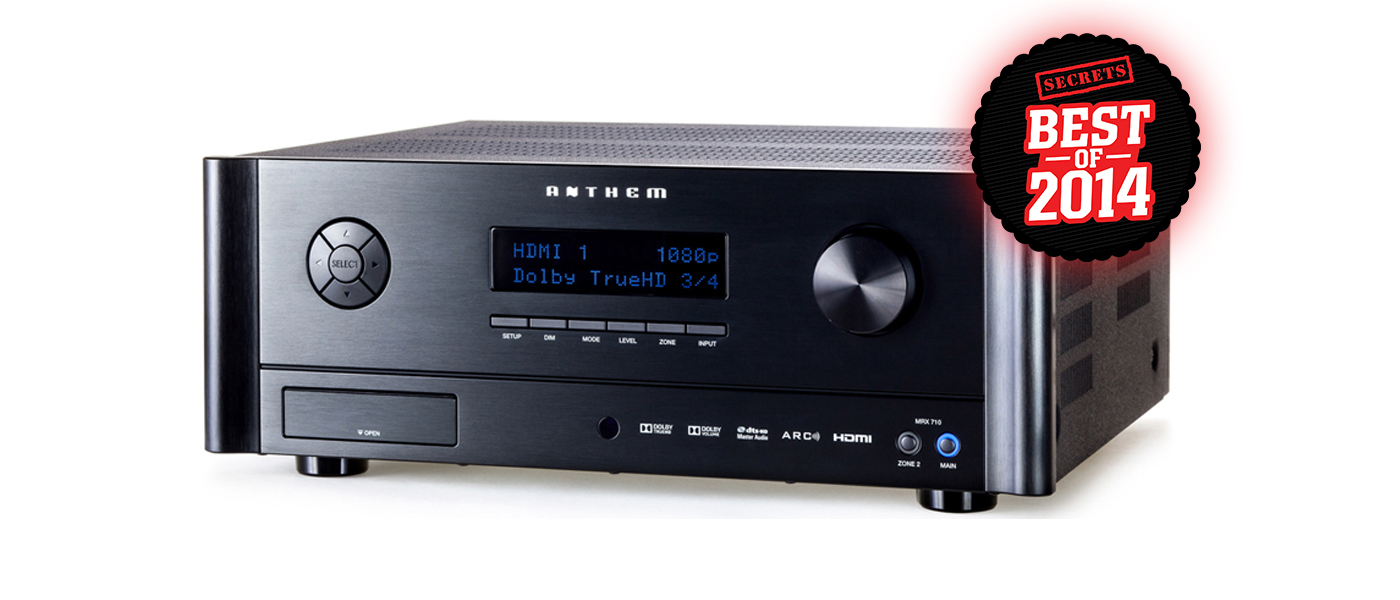

Introduction to the Pioneer SC-79 Receiver
The SC-79 marks the fourth revision of the Pioneer SC-line that I have reviewed. From the beginning I’ve been impressed with the amount of features they fit inside and the performance they offer. The SC-79 announcement is as excited for a new receiver as I have been. Far from a marginal upgrade, Pioneer went all-out and packed in new features galore. The biggest is a pair of ESS SABRE32 9016 DACs. A single-step below the 9018 used in top-flight two channel audio products, the 9016 is the highest end DAC in a receiver today.
Pioneer also adds HDBaseT, support for DSD audio over USB and LAN connections, and more. With the amount of features they added, I knew that I was going to need a lot of time to get through everything and see what the SC-79 has to offer me.
PIONEER SC-79 RECEIVER SPECIFICATIONS
- Design: 9.1 A/V Receiver
- Power Output: 140 WPC x 9, @ 1 kHz
- THD+N: 0.08% @ 8 Ohms
- Video Connections: HDMI 1.4a (8 rear in, 1 front in, 3 out), Component (3 in, 2 out), Composite (4 in, 1 out), HDBaseT
- Audio Connections: USB 2.0, RCA Stereo (5 in, 3 out), Optical (2 in, 1 out), Coaxial Digital (2 in, 0 out), Multichannel (11.2 preout), iPod, Sirius Radio, Bluetooth (optional), Phono (MM compatible)
- Other Connections: Ethernet (Internet Radio, Networked Audio, Firmware), 12V triggers (2), USB, RS-232, IR (2 in, 1 out), Headphone Jack (6.3mm)
- Dimensions: 7.3″ H x 17.1″ W x 17.4″ D
- Weight: 39 Pounds
- MSRP: $3,000 USD
- Pioneer
- SECRETS Tags: Pioneer, Receivers, Audio, 9.1
Design and Setup of the Pioneer SC-79 Receiver
Just like the models before it, the SC-79 utilizes Pioneer D3 Class D amplifiers. This lets them offer 9 channels of amplification at 140 watts per channel while remaining relatively compact. Many people won’t use all 9 channels in one room so they are available for bi-amping or for powering up to two additional zones of audio. While last year’s model, the SC-68, featured a HDMI output for Zone3 the HDBaseT port is brand new.
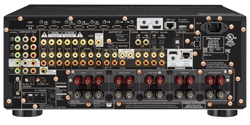
HDBaseT allows a full HDMI signal over conventional Cat5e or Cat6 wiring. HDMI cables are typically limited to 50′ unless you use Redmere, and become unwieldy at those lengths as well. Running a single Cat5e cable is both easier, due to size, and 100m lengths are supported. Now instead of being limited to a Zone in an adjacent room you can have a zone at the other end of the house and running off the SC-79. You will need a HDBaseT receiver that runs around $115 but the saving in using Cat5e over HDMI practically pays for that. It will even carry an Ethernet signal for you to that room.
Beyond this the SC-79 is stocked. 9 HDMI inputs mean even the largest systems are handled here and there is a plethora of legacy inputs as well. The USB input lets you use the ESS SABRE DACs in an Asynchronous connection to get any high-resolution audio from your PC to your system. Almost all home control systems are well supported, and the Control4 support made it easy to integrate it directly into my system.
I used the SC-79 in my living room system with five identical Paradigm MilenniaOne speakers and an SVS PB-1000 subwoofer. Running Full Auto MCACC setup on these leads to some interesting results. Despite the small size of the MilenniaOne and having a PB-1000 subwoofer, the Pioneer sets the Front and Surround speakers as large. The center channel is set to small, but this is the only speaker stand mounted and not wall mounted.
Looking at the EQ that MCACC applies, it seems that the SC-79 detects measureable bass response at 63 Hz and uses that to determine that the speakers are large. Even though it has to apply a +7 dB bump, that will introduce distortion across the whole range covered by that driver, it chooses this. To verify I ran a few tests using RoomEQ Wizard and adjusting the MCACC parameters.
RoomEQ measures bass out to 50 Hz with that +7 dB correction at 63Hz, but then it falls off a cliff. There is no usable bass below 42 Hz and there is a large dip at around 120 Hz. With a subwoofer bass response extends down to 20 Hz in the room and that dip at 120 Hz is gone. The 150 Hz crossover produces the most linear results and is what I used later. Since MCACC does not EQ the subwoofer below 63 Hz there is no correction applied to it. The volume could be lowered to reduce the bump from 20-50 Hz but it would worsen the room node dip at 63 Hz.
I recommend using manual setup for your speakers with the SC-79. You can set the speaker size manually and then let MCACC handle the rest, including distance and level. Those work correctly and account for delays often present in subwoofers. Using the Manual MCACC instead of Full Auto produces much better results that you will be happier with.
The Pioneer SC-79 Receiver In Use
Usual testing staples like Dave Matthews and Tim Reynolds: Live at Radio City are equally impressive on the Pioneer SC-79. Using the default MCACC settings, the SC-79 soundstage was narrow and thin, with no body to any of the music. Everyone was trapped in the center speaker as the soundstage collapsed between the speakers. Switching to the Manual MCACC settings the concert hall opens up in front of me. The body of the guitars returns and the stage extends deep into the wall and beyond the left and right speakers. Correct setup of a receiver makes a world of difference as the SC-79 sounded like a different beast once I adjust the settings.
In my system the SC-79 has no issues pushing the MillenniaOnes are loud as I can stand. I utilized the USB input to stream a variety of high-resolution audio tracks directly to the SC-79. With a Mac you don’t need to install a driver, but for Windows PCs a driver CD is inside the box.
Listening to high-resolution audio on the SC-79 is a wonderful experience. Using J River Media Center it is easy to send the audio directly from a PC with no processing or adjustments at all. Using 24/192 recordings the SC-79 is incredibly clear. Vocals are more realistic and instruments exist in a much more defined space than they do on CD-quality recordings. Norah Jones, Cat Stevens and Alison Krause never sound as real as they do with high-resolution downloads fed through the Pioneer SC-79.
For convenience the integrated AirPlay works as advertised. Streaming playlists from Spotify on my phone or tablet to the SC-79 is easy and works better than having to use an integrated app. Listening to The Civil Wars from, well, The Civil Wars is easy with only the rare drop out or other issue. It doesn’t provide the same potential quality as a hard-wired connection but the convenience makes it an essential addition. Bluetooth requires an additional dongle from Pioneer.
My kids both enjoy watching movies, so I see a lot of Pixar films now. During the island chase sequence of The Incredibles the effects of the ship whizzing around your hear are clear and continuous on the Pioneer SC-79. The dynamics of the robot attack on the city come alive with the crunching of cars and deep low bass. Vocals are always crisp and clear and there is plenty of power in reserve for dynamic sections.
The subtle sounds of Monsters Inc. are no less impressive through the SC-79. From the simple sound of countless doors closing to a roaring snowstorm in the Himalayas, the SC-79 handles everything well. One downside to the SC-79, which has been a problem for a while, is the remote. Countless tiny buttons that have 2-3 functions each make it hard to use. Using it in the dark is even harder to do and I highly recommend a universal model. I also think once you get to this price vendors should consider RF remotes instead of IR. A remote that uses RF or even Wi-Fi would be a very useful addition for the HDBaseT zone as well.
When it comes to pure performance the SC-79 is top-notch. Only with the room correction and the remote ergonomics does it trip up.
The Pioneer SC-79 Receiver On The Bench
The Pioneer SC-79 is one of the first products to be tested using an Audio Precision APx585 analyzer. With the ability to fully test HDMI, Coaxial, Optical, RCA, XLR and power amplifier sections, the APx585 allows completely reliable, accurate measurements to be made on components. After all, it’s what most of the companies use to design them. We’d like to thank Audio Precision for their time and for providing access to their test equipment and knowledge.
First, the analog input signal test results.
Running two channels at 1 kHz to 1% THD+N the Pioneer SC-79 managed to put out 129 watts into 8 ohms. With 0.1% THD+N power output drops to 125 watts into 8 ohms. Future tests will utilize 20 Hz – 20 kHz testing as well as 1 kHz tests as I’m still refining the APx585 tests.
The curve below shows output power at 1 kHz into 8 ohms vs. output level. Note that the distortion starts to increase at only 10 watts. The steep knee on the power output vs. THD-N chart is at 127.4 watts.
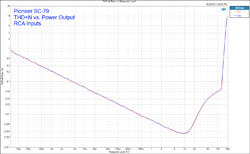
For the SC-79 first we will look at performance using the analog inputs with the volume set for unity gain (2V input, 2V output). Looking at THD vs. frequency with a 2V RMS signal, we see that THD remains constant from 200 Hz – 20 kHz. Many preamps show a rise in THD beyond 5 kHz but the SC-79 does not. The absolute value of 0.01% is higher than expected and the lower distortion below 200 Hz is uncommon to see.
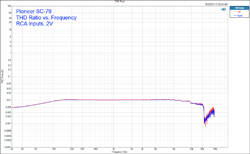
With a 1 kHz sine wave at 2 volts input as the test signal, THD+N was 019%. The harmonics are higher than expected, and the odd harmonics are larger than the even. The harmonics also do not reduce significantly with increasing harmonic order that you would normally expect.
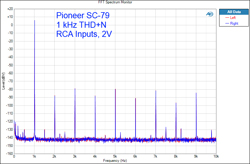
IMD was -76.2 dBV, or 0.01542%, using the standard SMPTE 60 Hz, 7 kHz combination of test tones.
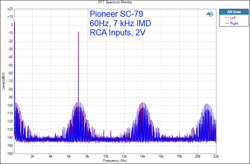
With 19 khz – 20 kHz test tones, IMD dropped to -89.00 dBV, or 0.00355%. What you can also see is that the noise floor rose with increasing frequency.
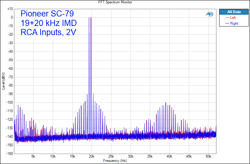
Frequency response was flat out to 50 kHz, with a maximum deviation of 0.012 dB from 20 Hz – 20 kHz.

Crosstalk was low, with a minimum at 100 Hz of -120dB and a maximum at 20 kHz around -76dB.
Signal to Noise ratio came in at 109.3 dB unfiltered and 116.1 dB with filters at 20 Hz and 20 kHz. Adding A-Weighing to that increases it to 118.6 dB.
And, now the digital test signal input test results.
The results were identical for HDMI, Optical, or Coaxial inputs, as all use the ESS SABRE chipset.
THD+N vs. Frequency from the digital inputs was similar to the analog input test results. Distortion was flat from 200 Hz to almost 20 kHz, and drops down below 200 Hz. The biggest change here is that THD+N increased when using the digital inputs instead of the analog inputs by a factor of 3. Given the quality of the ESS DAC, this appears to be an analog implementation issue.
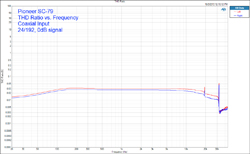
THD+N using a 1 kHz sine wave resulted again in higher odd-ordered harmonics, but they began to fall off, unlike the analog test. However the harmonics are higher to begin with than with the analog tests.

With the SPMTE IMD test, the 60 Hz tone had larger odd-order than even-order harmonics. IMD was only -64.35 dBV or 0.06800%. Once again, this is a level that is higher than with analog inputs.

The low level linearity of the ESS DAC was excellent. We can see this in a plot of a sign wave at -90 dB down with a 24 bit word. The amplitude is almost at the theoretical 90 mV peak, and the shape of the waveform is well preserved. This time domain result combined with the 116 dB SNR (Signal-to-Noise Ratio) shows the SC-79 can resolve 19 bits. The number of bits in the 24 bit word that can be resolved is derived by the following formula: (SNR – 1.76)/6.02. See David Rich’s article for a complete explanation of bit resolution.
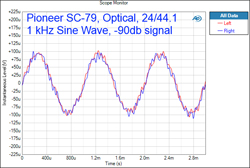
The performance of the Pioneer is a bit surprising. The high odd-ordered harmonics over RCA inputs indicate that it may run into some issues when used as a preamp. For full-scale digital signals, the distortion is even higher, which is unexpected; however, for low-level signals, the performance is close to the best achieved in an AVR at about 19 bits. It is not likely the distortion of the SC-79 will be audible, but the extraordinary (for an AVR) low level linearity and noise makes this an excellent candidate to reproduce high-resolution music.
Conclusions about the Pioneer SC-79 Receiver
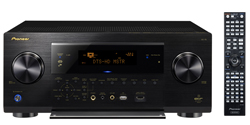
The Pioneer SC-79 adds more features to what was already a feature packed receiver. The updated SABRE DACs sound very good when sent high-quality audio like a Blu-ray disc or HD Tracks download. Even with lower quality sources like Spotify over AirPlay it sounds fantastic and has plenty of power in reserve. With HDBaseT it now works well for those that want to use is in two rooms at once. With the extra amplifier channels available and HDBaseT you can easily use it for a main theater room, music in another room, and sending video and audio over HDBaseT to another.
On the bench it is a good performer as well. The analog performance in preamp mode is as good, or better, than similarly priced preamps on the market today. The DACs ability comes across on the -90db sine wave test, showing performance that bests other models out there today. The issues I have with the Pioneer SC-79 are ones that have lingered from year to year. The remote really needs a redo at this point. A $3,000 receiver deserves a much better remote than the one that Pioneer still includes.
A larger issue is MCACC. The speaker detection method is prone to errors and might identify your speakers incorrectly. It is possible to set sizes and crossover correctly before running MCACC, but it needs to probe deeper to determine if it is correct. It also needs an EQ for the subwoofer channel. Other room correction systems, and people like me, find that bass correction is the most important thing an EQ system can do. Room issues in the lower frequencies are what need the most correction applied to them. Skipping those is a large oversight to me.
Everything considered, including the high price, the Pioneer SC-79 still stacks up very impressively to me. The power amplifier section can deliver when required and runs much cooler than other models. It also has a very high performing preamp section that competes with models costing just as much but that don’t include any amplification. The HDBaseT feature sets the Pioneer up for use with a custom control system and to serve as the hub for a whole-house AV solution.
I thought that receivers priced over $2,000 had gone away thanks to the recent economy. It turns out it was just on hiatus but now Pioneer is here to try to push the limits of what you can get inside a single box. The SC-79 shows that you can a box full of features without making them second-rate to do so.


